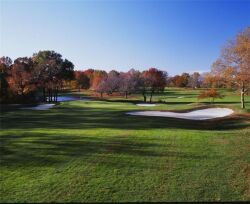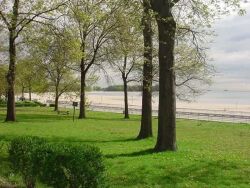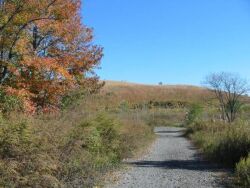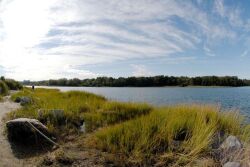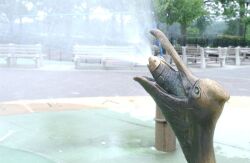Pelham Bay Park
The Lagoon
The lagoon has endured a long history of change. Located in the northeast corner of the Bronx, it originally included LeRoy’s Bay and spread out to meet the Long Island Sound. It was developed close to its current shape after the construction of Orchard Beach, created by Parks Commissioner Robert Moses (1888-1981) in 1936. Moses’s ambitious $8 million plan to renovate the area called for 115 new acres of land using over 3 million cubic yards of sanitation landfill to join Rodman’s Neck and Hunter Island. Construction crews added white sand from the Rockaways in Queens and Sandy Hook, New Jersey to the beach at a rate of 4,000 cubic yards a day.
The lagoon was widened and dredged when it was chosen as the site of the 1964 Olympic Rowing trials. In the process many small islands in the lagoon, such as Rodger’s Island, were eliminated. Parks built a viewing tower along the southeast edge of the lagoon for the trials, and the United States 1964 Olympic Rowing Team went on to win two gold medals, one silver medal, and one bronze medal in Tokyo, Japan.
The lagoon lies within Pelham Bay Park, between Hunter Island, Orchard Beach, and the main section where two golf courses are located. The primary acquisition of the park occurred in 1888, when the Bronx Parks Department assembled several large estates to form 1700 acres of parkland. The continuing acquisition of land over the ensuing decades has made Pelham Bay Park the largest park in New York City, at more than 2700 acres.
In 2000, Mayor Rudolph W. Giuliani provided $413,000 to fund a restoration of the lagoon salt marsh. One of New York City’s least known and most valuable natural resources are its salt marshes. Known as “transitional zones,” they lie at the border of land and sea, between the oceanwater and freshwater rivers and streams. Salt marshes flourish behind barriers of beach and sand, in the shelter of coves, lagoons, and bays, and along the banks of estuaries. Without these protective barriers, the pounding surf and shifting ocean currents would rapidly destroy salt marshes. Salt marshes act as natural filtration systems that trap pollutants that would otherwise contaminate our bays and oceans. They have a self-cleaning ability to absorb fertilizers and improve water quality. Salt marshes reduce erosion, and they provide a rich wildlife habitat.
The lagoon is home to a wide variety of wildlife in the green salt marsh and mudflats. Although few plants can survive in salt water, the salt marsh is calm enough for very distinctive vegetation to take root. Saltmarsh cordgrass (Spartina alterniflora), has flourished among the vast expanses of sand and silt that are covered twice a day by the ocean’s tides. As this specialized grass spreads densely, it traps floating debris. Sediment and particles of decaying plant and animal matter slowly build up in the intertidal area, forming nutrient-rich mud.
An abundance of creatures dwell beneath the life-sustaining mudflat, and they contribute to the ever-renewing foodchain of this sophisticated ecosystem. Wading birds, such as egrets and herons, and shorebirds, such as willets (Catoptrophorus semiplamatus) and killdeer (Charadrius vociferus), are seen on the mudflats. The great blue heron (Ardea herodias) and snowy egrets (Egretta thula) can be spotted in the tidal waters. They stand motionless on stilt-like legs, patiently awaiting their prey, and then lunge at the fish with a quick stab of their long, spear-like bills. The migrating ospreys (Pandion haliaetus) soar 40 feet above the surface and plunge to the water to dive for fish. The fish include small killifish (Fundulus diaphanus) and silversides (Menidia notata).
Check out your park's Vital Signs
Clean & Safe
Green & Resilient
Empowered & Engaged Users
Share your feedback or learn more about how this park is part of a
Vital Park System

Know Before You Go

Contacts
Pelham Bay Park Administrator's Office: (718) 430-1891
Bartow-Pell Mansion Museum: (718) 885-1461
Park Enforcement Patrol: (718) 430-1815

